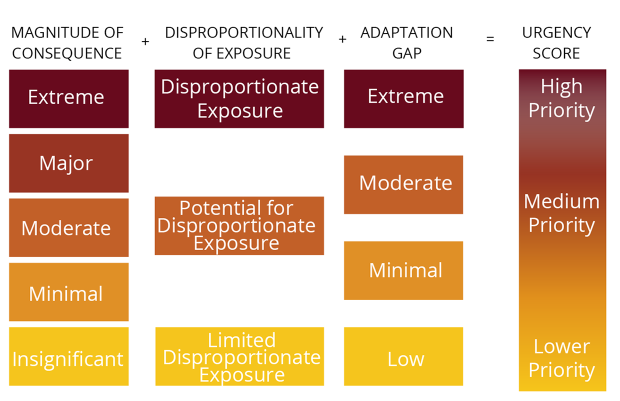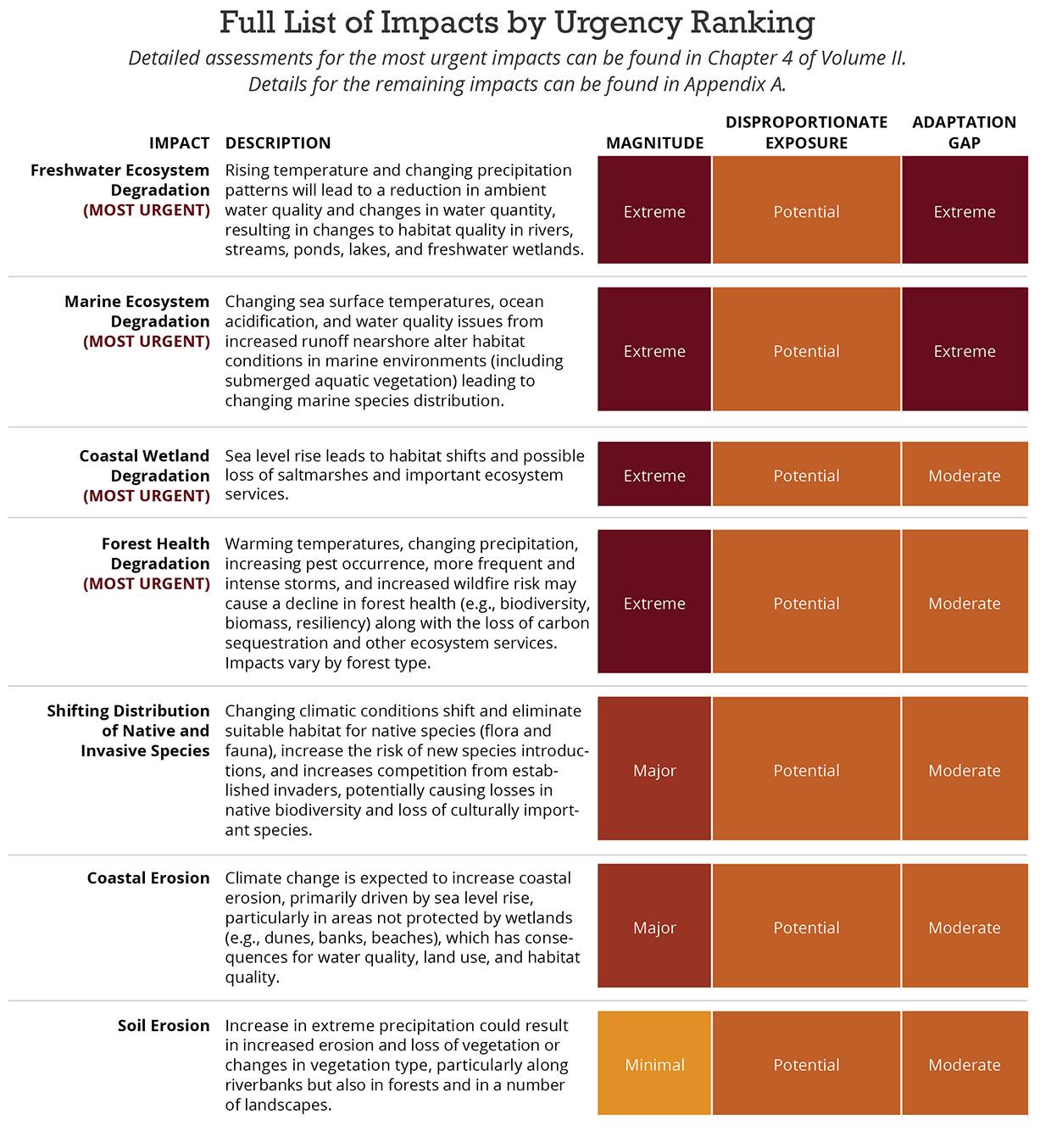Overview
This Climate Assessment considers impacts across five sectors which represent major categories of projected impacts of climate change with common groupings of exposed assets, individuals, or resources, and that generally fall under the responsibility of similar state agencies. The primary objective of the Climate Assessment is to identify urgent climate risk statewide, as well as by each region and sector. Risk rankings were developed through discussions with the project working group and stakeholders, and considered:
-
How big of a climate effect will this have? Quantitative and qualitative indicators of the scale of potential impact, analyzed under the defined future climate scenario.
-
Will populations living in environmental justice areas be disproportionately affected? Demographic analysis of the distribution of impact across populations, particularly the Commonwealth’s identified environmental justice and socially vulnerable groups.
-
Are we currently doing enough to adapt to this impact? Assessment of current and planned adaptation plans and actions, and the potential benefits of additional adaptation action.
-
Sectors are a helpful organizational structure and allow for the prioritization across impacts with similar types of effects. However, it is important to note that the effects of climate change do not fall neatly within the defined sectors, and there are many interactions between impacts both within and across sectors. To the extent possible, these interactions are noted in the Climate Assessment in order to help draw these connections that may not be seen in the quantitative sectoral analysis.
Full List of Impacts in the Natural Environment Sector
Seven impacts were evaluated within the Natural Environment Sector. Detailed assessments for the most urgent impacts can be found below and in Chapter 4 of Volume II. Details for the remaining impacts can be found in Appendix A. Due to tied scores in the urgency rankings, the Natural Environment sector has four most urgent impacts.
Most Urgent Freshwater Ecosystem Degradation
Rising temperature and changing precipitation patterns lead to a reduction in ambient water quality and changes in water quantity, resulting in changes to habitat quality in rivers, streams, ponds, lakes, and freshwater wetlands.
Extreme Level of Consequence
Some coldwater habitats expected to transition to cool- and warmwater habitats across the Commonwealth; harmful algal blooms and low dissolved oxygen threaten rivers, lakes, and ponds.
Potential for Disproportionality
Natural Environment sector impacts scored as “potential” because of focus on impacts on natural environments rather than the indirect impacts on humans captured in other sectors.
Extreme Adaptation Gap
Direct ecosystem restoration, green infrastructure, and land management planning are effective, but more watershed- and basin-level coordination would continue to help facilitate adaptation.
Most Urgent Impact: Marine Ecosystem Degradation
Changing sea surface temperatures, ocean acidification, and water quality issues from increased runoff nearshore alter habitat conditions in marine environments (including submerged aquatic vegetation) leading to changing marine species distribution.
Extreme Level of Consequence
Sea surface temperature in the Gulf of Maine is expected to rise by 5 to 10 degrees Fahrenheit by 2100.
Potential for Disproportionality
Natural Environment sector impacts scored as “potential” because of focus on impacts on natural environments rather than the indirect impacts on humans captured in other sectors.
Extreme Adaptation Gap
Some local plans address nearshore ecosystems and the Commonwealth has studied ocean acidification but adaptation may require more regional cooperation.
Most Urgent Impact: Coastal Wetland Degradation
Climate impacts such as increased temperatures, increased runoff/precipitation, invasive species and drought act as stressors to coastal wetland environments. However, when considering coastal wetland degradation on a regional scale, sea level rise leads to the highest degree of habitat shifts and possible loss of salt marshes and their important ecosystem services.
Extreme Level of Consequence
66 percent of today’s total marsh area in the Commonwealth is projected to transition to other marsh types or habitats by 2070.
Potential for Disproportionality
Natural Environment sector impacts scored as “potential” because of focus on impacts on natural environments rather than the indirect impacts on humans captured in other sectors.
Moderate Adaptation Gap
Salt marsh restoration projects are underway across the coast; however, more restoration and planning are needed
Most Urgent Impact: Forest Health Degradation
Warming temperatures, changing precipitation increasing pest occurrence, more frequent and intense storms, and increased wildfire risk may cause a decline in forest health (e.g., biodiversity, biomass, resiliency) along with the loss of carbon sequestration and other ecosystem services. Impacts vary by forest type.
Extreme Level of Consequence
High temperatures, drought, pests, and wildfires lead to habitat transition and degradation of ecosystem services,with some tree species faring better than others.
Potential for Disproportionality
Natural Environment sector impacts scored as “potential” because of focus on impacts on natural environments rather than the indirect impacts on humans captured in other sectors.
Moderate Adaptation Gap
Actions recently identified in the Massachusetts Clean Energy and Climate Plan for 2025 and 2030 will help reduce forest degradation.
Quick links
- ResilientMass Homepage
- ResilientMass Site Map
- Massachusetts Climate Change Assessment
- Massachusetts Climate Change Assessment – Human Sector
- Massachusetts Climate Change Assessment – Infrastructure Sector
- Massachusetts Climate Change Assessment – Governance Sector
- Massachusetts Climate Change Assessment – Economy Sector
- Massachusetts Climate Change Assessment – Full Statewide Report Volume II
- Massachusetts Climate Change Assessment – Full Statewide Report Volume II, Appendix A
- 2023 ResilientMass Plan
- 2023 ResilientMass Action Tracker




